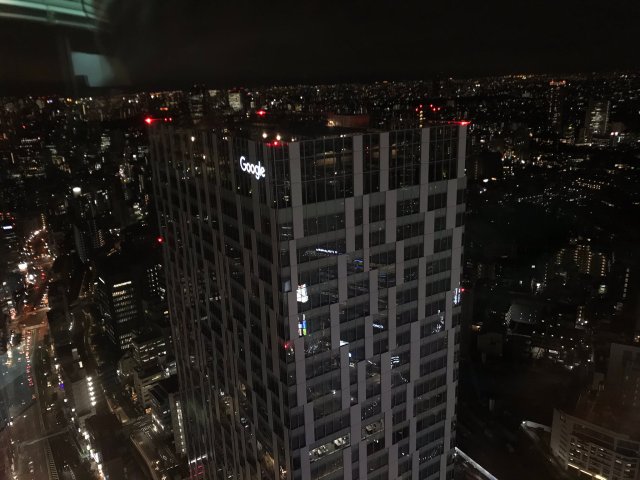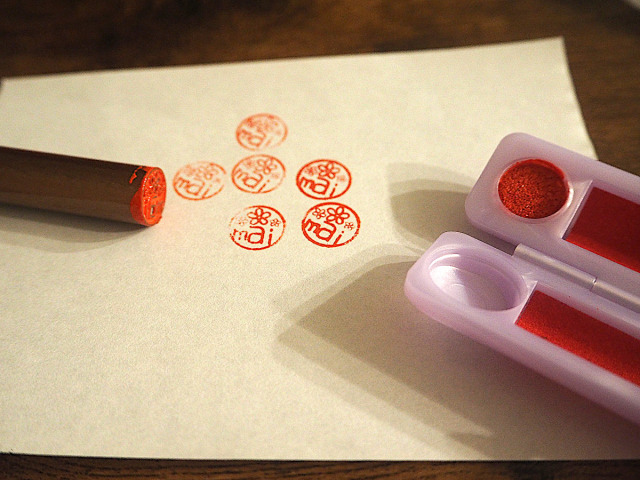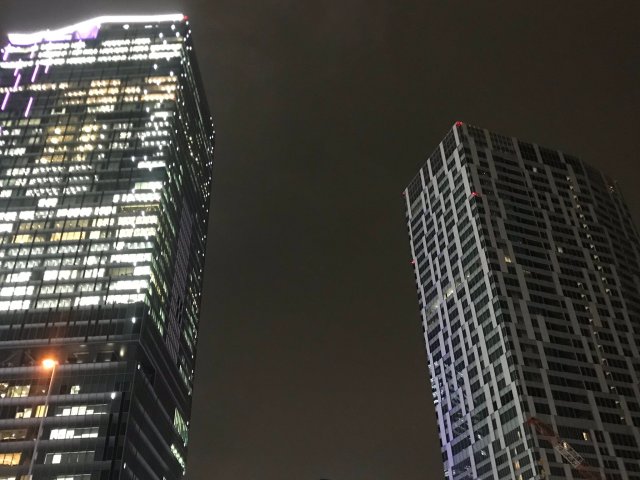
Two office skyscrapers look out over Shibuya together, but inside they’re worlds apart.
A lot has been written about Japanese working culture, where it’s standard practice to put in a lot of unpaid overtime, use your paid holidays on sick days, and only head off home after your boss has left the office.
This focus on prioritising group harmony over efficiency in Japanese workplaces is in stark contrast to the “work smarter not harder” mentality employed by many western companies, and to see it in practice, all you have to do is look up at Japan’s office skyscrapers at night.
That’s what Twitter user Yusaku Arai (@arai_yusaku) did one evening while out at Shibuya at around 6:00 p.m., and what he saw was pretty astonishing. He snapped a photo of the scene, which showed a building on the left where Japanese companies are located, and a building on the right, which houses a western company.
これ今の渋谷なんだけど、
— 新井勇作 📷 Yusaku Arai (@arai_yusaku) October 15, 2020
衝撃の写真。
左側: Cyber Agent & Mixi
右側: Google
働き方改革は、効率改革。リモートワークの実態が激しすぎるな。。。 pic.twitter.com/oET7YbhDZ3
The office building on the left is the new 47-floor Shibuya Scramble Square, which is home to a number of big Japanese companies, including digital advertising company CyberAgent Inc., located on floors 19-23, and Mixi, an online social networking service, located on floors 28-36.
The building on the right? That’s the Shibuya Stream building, which is home to Google.
As you can see, the lights are shining brightly on practically every floor of Shibuya Scramble Square, whereas the Google headquarters, which takes up most of the 35-floor Shibuya Stream building, is so dark you can see the city lights reflecting off the windows, making it look almost transparent.
The reason why it’s so dark in there is because the tech giant has decided to allow its employees to telecommute until the end of June 2021. Opposite Google, though, we can see that telecommuting hasn’t quite caught on in Japan, despite Tokyo Governor Yuriko Koike urging workers to work from home as much as possible back when the pandemic first arrived in the country.
There are a number of reasons why telecommuting isn’t a practical option for a lot of Japanese companies, as the importance of face-to-face meetings and the intricate web of Japanese group dynamics can be hard to nurture and maintain through video calls — how can you trust someone if you don’t know whether they’re wearing business trousers or a fundoshi loincloth? — and there’s also the problem of workers needing to go in to the office to “sign” forms and authenticate work documents using personal seals known as hanko.

The Minister for Administrative Reform, Taro Kono, has made it his mission to abolish the need for personal seals in Japanese workplaces, which many believe to be an outdated practice. Kono is also determined to do away with fax machines, which still play a large role in offices as well.
Kono, and many others, believe that these types of traditional office practices are holding Japan back from truly embracing telecommuting and improving workplace efficiency. It’s not doing much to help the environment either, because as the photo of the two buildings in Shibuya shows, as long as people have to head in to the office every day and stay there until the time is right to head home, buildings in Tokyo will be guzzling up energy and lighting up the night until the last train departs out of the city.
Source: Twitter/@arai_yusaku via Hachima Kikou
Featured image: Twitter/@arai_yusaku
● Want to hear about SoraNews24’s latest articles as soon as they’re published? Follow us on Facebook and Twitter!


 How is Japan coping with telecommuting? Survey asks for the good and bad of working from home
How is Japan coping with telecommuting? Survey asks for the good and bad of working from home Japanese overtime work culture captured in new dice collection
Japanese overtime work culture captured in new dice collection Government survey finds teleworking at least once per week raises Japanese worker happiness level
Government survey finds teleworking at least once per week raises Japanese worker happiness level Final Fantasy developer Square Enix makes working from home a permanent option for employees
Final Fantasy developer Square Enix makes working from home a permanent option for employees Japan’s All-Alone Tents see skyrocketing demand during coronavirus pandemic
Japan’s All-Alone Tents see skyrocketing demand during coronavirus pandemic Play games, learn, and get your fortune at Ginza’s limited-time Tsunaguu “Shrine of the Future”
Play games, learn, and get your fortune at Ginza’s limited-time Tsunaguu “Shrine of the Future” Japanese beef bowl chain Sukiya’s 2026 Smile Box lucky bag basically pays for itself
Japanese beef bowl chain Sukiya’s 2026 Smile Box lucky bag basically pays for itself The best Starbucks Japan Frappuccinos we want to drink again in 2026
The best Starbucks Japan Frappuccinos we want to drink again in 2026 Japan Airlines is giving away free domestic flights to international tourists
Japan Airlines is giving away free domestic flights to international tourists Starbucks Japan unveils New Year’s collection for 2024, with daruma, dragons and Mt Fuji for luck
Starbucks Japan unveils New Year’s collection for 2024, with daruma, dragons and Mt Fuji for luck 7 great places to see Mt. Fuji from without having to climb it
7 great places to see Mt. Fuji from without having to climb it Japanese confectionary chain Chateraise opens first 24-hour branch with self-checkout
Japanese confectionary chain Chateraise opens first 24-hour branch with self-checkout Serpentine Winnie the Pooh Year of the Snake plushies, Mickey and Baymax daruma arrive in Japan
Serpentine Winnie the Pooh Year of the Snake plushies, Mickey and Baymax daruma arrive in Japan Haunted hospital near Mt Fuji re-opens after renovation at Fuji-Q Highland, and it’s terrifying
Haunted hospital near Mt Fuji re-opens after renovation at Fuji-Q Highland, and it’s terrifying We go behind the scenes at Japan Airlines’ in-flight meal factory【Photos】
We go behind the scenes at Japan Airlines’ in-flight meal factory【Photos】 Starbucks Japan ready to get Year of the Horse started with adorable drinkware and plushies【Pics】
Starbucks Japan ready to get Year of the Horse started with adorable drinkware and plushies【Pics】 Cyberpunk anime meets traditional culture in Ghost in the Shell gold leaf Japanese changing screens
Cyberpunk anime meets traditional culture in Ghost in the Shell gold leaf Japanese changing screens Hayao Miyazaki says Happy New Year to Studio Ghibli fans with new art for Year of the Horse
Hayao Miyazaki says Happy New Year to Studio Ghibli fans with new art for Year of the Horse Hello Kitty Choco Egg figures are an adorable trip through three periods of Japanese pop culture【Pics】
Hello Kitty Choco Egg figures are an adorable trip through three periods of Japanese pop culture【Pics】 We found possibly the quietest Japanese-style hotel in Tokyo’s bustling Shinjuku district
We found possibly the quietest Japanese-style hotel in Tokyo’s bustling Shinjuku district 7-Eleven Japan’s ramen-cooking robot whipped us up a bowl of noodles【Taste test】
7-Eleven Japan’s ramen-cooking robot whipped us up a bowl of noodles【Taste test】 Sumo Sanrio! Hello Kitty and pals team up with Japan Sumo Association for new merch【Pics】
Sumo Sanrio! Hello Kitty and pals team up with Japan Sumo Association for new merch【Pics】 Japan’s oldest largetooth sawfish in captivity back on display in Mie Prefecture
Japan’s oldest largetooth sawfish in captivity back on display in Mie Prefecture More Than a Capsule Stay: Why Solo Travelers Choose “global cabin Yokohama Chinatown”
More Than a Capsule Stay: Why Solo Travelers Choose “global cabin Yokohama Chinatown” 7-Eleven Japan starts new temporary luggage storage service in over 300 branches
7-Eleven Japan starts new temporary luggage storage service in over 300 branches Disillusionment at Tsukiji’s tourist-target prices led us to a great ramen restaurant in Tokyo
Disillusionment at Tsukiji’s tourist-target prices led us to a great ramen restaurant in Tokyo Starbucks teams up with 166-year-old Kyoto doll maker for Year of the Horse decorations【Photos】
Starbucks teams up with 166-year-old Kyoto doll maker for Year of the Horse decorations【Photos】 Tokyo considering law requiring more trash cans following litter increase in heavily touristed area
Tokyo considering law requiring more trash cans following litter increase in heavily touristed area Tokyo’s Tsukiji sushi neighborhood asks tour groups to stay away for the rest of the month
Tokyo’s Tsukiji sushi neighborhood asks tour groups to stay away for the rest of the month Tokyo event lets you travel back in time, for free, to celebrate 100 years since Showa era start
Tokyo event lets you travel back in time, for free, to celebrate 100 years since Showa era start Sanrio theme park in Japan announces plans to expand into a Sanrio resort
Sanrio theme park in Japan announces plans to expand into a Sanrio resort Japan may add Japanese language proficiency, lifestyle classes to permanent foreign resident requirements
Japan may add Japanese language proficiency, lifestyle classes to permanent foreign resident requirements Stamina-destroying “Paralysis Noodles” are Tokyo’s newest over-the-top ramen innovation
Stamina-destroying “Paralysis Noodles” are Tokyo’s newest over-the-top ramen innovation Survey asks foreign tourists what bothered them in Japan, more than half gave same answer
Survey asks foreign tourists what bothered them in Japan, more than half gave same answer Japan’s human washing machines will go on sale to general public, demos to be held in Tokyo
Japan’s human washing machines will go on sale to general public, demos to be held in Tokyo Japan’s deadliest food claims more victims, but why do people keep eating it for New Year’s?
Japan’s deadliest food claims more victims, but why do people keep eating it for New Year’s? We deeply regret going into this tunnel on our walk in the mountains of Japan
We deeply regret going into this tunnel on our walk in the mountains of Japan Studio Ghibli releases Kodama forest spirits from Princess Mononoke to light up your home
Studio Ghibli releases Kodama forest spirits from Princess Mononoke to light up your home Major Japanese hotel chain says reservations via overseas booking sites may not be valid
Major Japanese hotel chain says reservations via overseas booking sites may not be valid Put sesame oil in your coffee? Japanese maker says it’s the best way to start your day【Taste test】
Put sesame oil in your coffee? Japanese maker says it’s the best way to start your day【Taste test】 No more using real katana for tourism activities, Japan’s National Police Agency says
No more using real katana for tourism activities, Japan’s National Police Agency says Starbucks Japan reveals new sakura drinkware collection, inspired by evening cherry blossoms
Starbucks Japan reveals new sakura drinkware collection, inspired by evening cherry blossoms Updated cherry blossom forecast shows extra-long sakura season for Japan this year
Updated cherry blossom forecast shows extra-long sakura season for Japan this year Need a work-from-home office fast? Set up this Japanese cardboard desk in less than 1 minute
Need a work-from-home office fast? Set up this Japanese cardboard desk in less than 1 minute Survey reveals most Japanese workers want to work from home at least twice per week
Survey reveals most Japanese workers want to work from home at least twice per week Why work from home when you can work from a Japanese cat town?
Why work from home when you can work from a Japanese cat town? Breathtaking pixel art video shows 100 years of Japanese work culture changes【Video】
Breathtaking pixel art video shows 100 years of Japanese work culture changes【Video】 Japanese worker orders bento lunch, gets punished with televised apology and docked pay
Japanese worker orders bento lunch, gets punished with televised apology and docked pay Tokyo Hooters now offers rental work spaces, and they’re free for students
Tokyo Hooters now offers rental work spaces, and they’re free for students Eight things people realized were pointless about Japanese work culture during 2020
Eight things people realized were pointless about Japanese work culture during 2020 The SoraNews24 Work from Home Health Guide: Stretching with Mr. Sato!【Photos】
The SoraNews24 Work from Home Health Guide: Stretching with Mr. Sato!【Photos】 Japanese company prohibits employees from smoking on their commute to the office
Japanese company prohibits employees from smoking on their commute to the office From capsule hotel to capsule office – A visit to Tokyo’s newest pandemic work solution
From capsule hotel to capsule office – A visit to Tokyo’s newest pandemic work solution Japanese woman fed up with being expected to serve male coworkers tea shatters corporate culture
Japanese woman fed up with being expected to serve male coworkers tea shatters corporate culture Foreigner disappointed by Japan’s hazy concept of “work ending times,” so are Japanese people
Foreigner disappointed by Japan’s hazy concept of “work ending times,” so are Japanese people 20 signs that a woman should think about quitting the Japanese company she works for
20 signs that a woman should think about quitting the Japanese company she works for Hamsters, Ebola & magic kanji: 7 tweets from Japanese office workers that went viral
Hamsters, Ebola & magic kanji: 7 tweets from Japanese office workers that went viral Despite their hardworking image, are the Japanese really just as lazy as the rest of us?
Despite their hardworking image, are the Japanese really just as lazy as the rest of us?
Leave a Reply